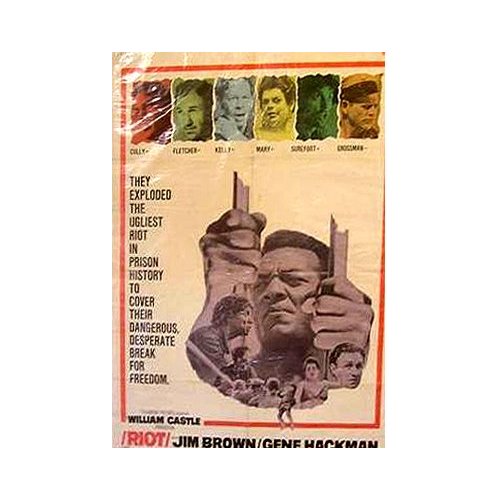 “Riot” suffers from deliberately slow pacing and some truly bizarre moments, yet the glue that holds this grimy, gritty prison picture together is the second pairing of two tough guys, Jim Brown and Gene Hackman. The first time they appeared together was in “The Split,” among a star-studded cast, and while this is ultimately the weaker of the two, it is still packs an wallop when all is said and done.
“Riot” suffers from deliberately slow pacing and some truly bizarre moments, yet the glue that holds this grimy, gritty prison picture together is the second pairing of two tough guys, Jim Brown and Gene Hackman. The first time they appeared together was in “The Split,” among a star-studded cast, and while this is ultimately the weaker of the two, it is still packs an wallop when all is said and done.
Red Fraker (Hackman) has come up with a scheme to break out of prison that starts with the convicts in solitary confinement, but his plans are fumbled by some bad planning and a possible snitch.
The alarm sounds off early in the film, causing panic among the participating members of this daring escape. On top of that, reporters show up, causing Fraker to create a new plan, and he has to come up with one quickly or he’ll get a longer prison sentence. He hatches a plan to make what is now a full-scale riot seem like a protest for better prison conditions, and while negotiations are being made, a tunnel is formed under the auditorium.
Similar to Dante in “Clerks,” Cully Briston (Brown) shouldn’t have even been there – it is a matter of being at the wrong place at the wrong time. Falsely being hassled by a prison guard, Briston is thrown right into solitary confinement for the beginning of the riot. He has a short time left to serve and is now forced into this crazy scheme, leaving him two choices: Serve a longer term or breakout of Arizona State Penitentiary.
What is a man to do?
An unlikely bond is formed between Hackman and Brown, which makes up the heart of this motion picture. Their friendship and respect for one another allows them to trust each other and force them to be honest when they are facing the worst. At one point, Hackman’s character starts to believe in the protest and gets caught up with being a hero for the prisoners, and it is Brown that talks him back to Earth.
But make no mistake – this is Brown’s picture, and he is the star. Having been a great NFL player, Brown easily made the transition to movies with features such as “Ice Station Zebra” and “The Dirty Dozen” before becoming a major player in blaxploitation cinema with “Slaughter” and the lousy sequel (featuring Ed McMahon as the villain). With his calm and cool onscreen confidence, it would have been great if he got more leading roles like Briston. He is tough, and has nothing to prove to anyone but himself.
Around this time, Hackman had to make the name for himself that he has now, and performed in many supporting roles (Most notably “Bonnie and Clyde”). It was not until “I Never Sang For My Father” and “The French Connection” that he became a leading man. But even in a supporting role, he gave leading-man caliber performances, and endured through some low-budget pictures. His performance in “Riot” is simple and understated, allowing you to know a lot about him through some pivotal scenes.
Interesting a side note on Hackman: It was not until “Scarecrow” that he lost interest in acting due to the poor audience response, because it was a film he truly adored making and started only taking scripts for the money.
It has been said that he turned down “One Flew Over the Cuckoo’s Nest” to make “March or Die” because the salary was higher. That is truly sad because over time, “Scarecrow” has developed the true following that it initially deserved.
The film used the authentic location of Arizona State Penitentiary and an actual warden (Frank A. Eyman) as the no-nonsense, gas-loving man in charge. That leads to a genuine sense of a real prison riot and life in confinement.
But the major flaw to “Riot” is a bizarre scene that involves prisoners dressing up as women and doing strip teases. This leads to a priceless scene of camp when a gay prisoner tries to seduce Brown’s character, and with no words, he manages to convey his disgust. The only explanation for that scene is to expose how out of hand this riot has gotten and that our main characters are no longer in control, but it comes off as unneeded and campy for this type of movie.
The other flaw happens to be that it is slow-moving, involving long stretches where nothing happens or enhances the plot. It is lazy scriptwriting, and not the fault of any of the film’s performers.
Flaws aside, there is enough to enjoy in “Riot” to make it worthy of your time, considering that is far from an Oscar contender. It is, overall, a B-movie with a low budget that captures the early talent of Hackman and the unused potential in Brown.

Leave a Reply